Tire change
Questions upon questions often arise when it comes to the topic of a tire change. The correct procedure for a tire change including balancing and changing valves is an essential part of a workshop's skill set. Find out what causes a steering wheel to wobble, when tire changes are necessary and why your car tire loses air here in our FAQs!
As soon as temperatures drop, summer tires do not perform as well as during warmer climate. The same applies to winter tires when temperatures rise during the summer months. This causes a significant increase in the risk of accidents for drivers and fellow road users. Consequently, most drivers should have their car undergo a tire change at least twice
a year!
But did you know that there is a clear difference between the terms "wheel change" and " tire change"? Whereas a workshop carries out a complete change of the tire and rim when changing a wheel, a tire change involves removing the rubber from the steel or aluminium rim. At the same time, the valve and, if necessary, the pre-existing tire pressure monitoring system (TPMS) are replaced. Whenever a tire is changed, possible imbalances need to be checked, and, if necessary, corrected with counterweights before the entire wheel is fitted to the vehicle.
When the tyre does not run smoothly and the steering wheel shakes
Your (new) tyres were just changed, but the wheels do not run smoothly and the steering wheel shakes when driving at higher speed? A steering wheel shakes when driving at high velocity if the wheel weights are not correctly balanced out after a tyre change. A simple rebalancing of the tyres can already be the solution to a shaking steering wheel. However, an imbalance of the tyres is not the only possible cause.
In case that repeated readjusting of balancing weights does not solve the problem of a shaking steering wheel, a so-called radial runout can trigger the vibration while driving. This can occur when tyres lock up during emergency braking or when your tyres hit a curb at high speed.
Improper storage and transport errors can also promote the radial run of a steering wheel. It is crucial to examine rims more closely when there is a problem with a shaking steering wheel. Rims are prone to lose balance. It helps to readjust the position of the wheel on the rim to cancel out imbalances and thus to steady the steering wheel. In most cases, this eliminates the annoying steering wheel flutter.
Radial runouts cannot always be detected by a balancer. Therefore, sometimes the only way to detect a defect is by test-driving the vehicle and thus to deduce the origin of a shaking steering wheel.
When the tyre of your car keeps losing air
The regular checking of tyre pressure is of great importance for road safety. So much for theory - but how often is the air pressure in the tyres checked in practice? For the vast majority of drivers, workshops measure the tyre pressure only twice a year, along with changing tyres and checking for imbalances. When a tyre loses air, it often happens gradually and only detected when the air pressure reaches the minimum amount. A tyre can keep losing air due to the following factors.
Damage or hairline cracks in the rim can cause the loss of tyre pressure . Often, however, the cause lies with the tyre valve:
- The valve is defective:
Air escapes slowly from the wheel when the valve is defective, or the valve cap was inadvertently not closed correctly during the last tyre inflation at the gas station.
- The valve is not positioned correctly:
The tyre loses air when after changing a tyre the valve is not put correctly on the opening of the rim.
TIP: By pressing the valve pin several times, the air escapes at high pressure. With a little luck, this will blow the dust grains out of the valve. After inflating the tyre with the suggested air pressure, there should be nothing to prevent you from continuing your journey safely!
Wheel balance
Why do I need to balance my tires? It is a commonly asked question among drivers when changing their tires. The answer is quite clear: Yes! No matter whether it is a static or dynamic imbalance: A wheel imbalance and the resulting consequences in regards to safety and driving comfort should not be underestimated.
In the FAQ section on balancing tires we want to answer frequently asked questions. Why do you have to balance tires? What happens if you do not balance tires and what does wheel imbalance actually mean? You will find the answers and much more information about balancing tires here.
What is an imbalance?
An imbalance of a wheel occurs when the axis of rotation does not correspond to one of the mass centroid axes. Poorly-balanced wheels can generate a critical condition on the vehicle:
- The steering vibrates
- More stress on wheel suspension and bearings
- More noticeable vibrations in the interior
- Physical strain on the body increases
- Increased brake wear can result
- Increased tire wear can result
- Extension of the braking distance may be the result
What does wheel imbalance mean? A wheel imbalance is an uneven distribution of the weight of the tyre around the center axis that causes the tyre not to rotate symmetrically without further adjustment, and the vehicle, therefore, runs non-circular. Wheel imbalances are a common problem. The valve alone can lead to a wheel imbalance when changing the car valve.
By means of our balancing weights, these axles are brought back into balance. You can find an overview of our balancing weights in our WEGMANN automotive B2B Partner Shop.
How does a wheel imbalance occur?
A wheel imbalance is caused by wear and tear in everyday situations such as potholes, heavy braking or curb bumping. A reason for sudden wheel imbalances could also be due to lost balancing weights that fell off the rim and were not replaced.
Why do you have to balance wheels?
At a speed of 100 km/h, the centrifugal force of a 10 g imbalance is equal to that of a sledge hammer.
Double this speed and the forces involved quadruple. Vehicles with poorly balanced wheels become dangerous:
- More stress on wheel suspension components and bearing points
- Noticeable vibrations on the steering wheel and in the interior
- Body subjected to greater physical stress
- Increased brake wear
- Increased heel and toe wear on tyres
- Braking distance increases
What is dynamic imbalance?
Dynamic imbalance is caused by an asymmetric mass distribution inside and/or outside of the rim. The asymmetric mass distribution is only visible during movement when the forces work in different directions and cause the wheel to hop or wobble. To determine a dynamic imbalance the tire/wheel assemblies can be checked on a balancing machine.
The dynamic imbalance can be compensated by applying wheel balance weights on the outer and inner side of the rim.
In addition to dynamic unbalance, there is also static unbalance.
What is static imbalance?
A correctly balanced wheel can rotate freely around its horizontal axis and is able to stop in every position. If there is a static imbalance, the spot on the wheel with the greatest mass is acted upon by gravity to deflect the wheel downward.
Static imbalance always occurs in the center of the wheel and causes it to bounce while driving. The static imbalance can be compensated by applying wheel balance weights on the opposite side of the occurred imbalance:
In addition to static unbalance, there is also dynamic unbalance.
What does balancing tyres mean?
The term tyre balancing refers to the correction of an imbalance of a tyre. Attaching counterweights eliminates the uneven distribution of the tyre weight. This so-called tyre balancing allows the tyre to run smoothly.
What damage can be caused by imbalances?
What exactly happens in a vehicle which moves with an imbalance and how can the driver detect an imbalance?
The results of endurance test conducted by HOFMANN POWER WEIGHT are clear after just 17,000 test kilometres. An imbalance has a significant effect on the vehicle. The effects are seen in three areas:
- comfort,
- safty and
- wear.
Strong vibrations at the steering wheel and inside the vehicle, along with constant humming noises are the first signs of an imbalance.
After 2,000 km of driving, significant uneven tyre wear is detected on all four wheels. Early repairs may be necessary due to increased wear at the suspension arms, shock absorbers and bearings. In the braking test conducted by HOFMANN POWER WEIGHT, the braking distance of the test Golf moving at a speed of 140 km/h increased by 6 mtr. This can be decisive in case of an emergency situation.
How do you remove an imbalance?
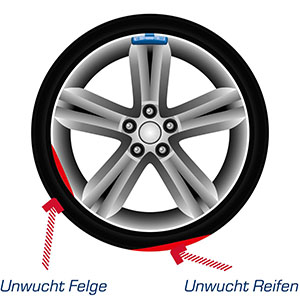 |
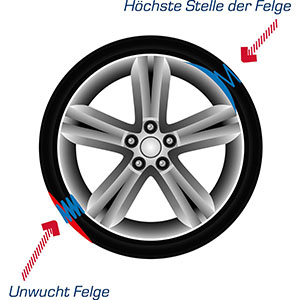 |
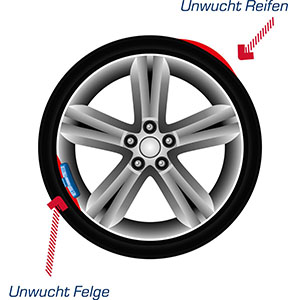 |
| The imbalance of the tyre and rim is measured by the balancing machine and the problem is corrected using balance weights. | This workshop procedure involves redating the tyre on the rim until the sources of imbalance on the rim and tyre are opposite each other. The residual imbalance is compensated with balance weights. |
A form defect of the rim can only be compensated by uneven tyre deflection. Smooth running optimisation involves placing the heavy and hard area of the tyre opposite the highest area of the rim. The residual imbalance is compensated with balance weights. |
How does tyre balancing work?
Tyre balancing requires a special machine - a wheel balancing machine. Therefore, tyre balancing is only possible in the car workshop. The wheel is clamped in the machine and the machine initiates the rotation of the wheel. The wheel balancing machine uses sensors to determine if and where an imbalance occurs and how large it is. Counterweights, so-called balancing weights, are then attached to the rim to correct the imbalance and ensure that the wheel runs round and smoothly. The balancing machine shows where exactly these weights are to be attached for tyre balancing. How to remove balancing weights, such as adhesive weights, can be found in our FAQ section on removing adhesive weights.
In addition to this so-called static balancing, where the wheel is removed from the vehicle, dynamic balancing is another alternative. It is an electronic fine balancing process in which the rotation of the wheel is tested directly on the vehicle for further imbalances. Reasons for the need to balance the tyres again can be brake discs, brake drums or wheel hubs, which are not investigated during static balancing.
What are the possibilities of balancing?
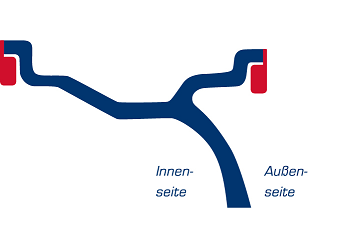 |
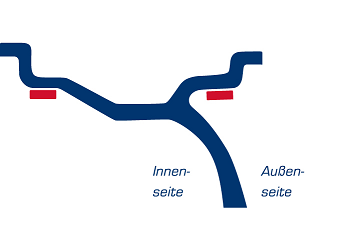 |
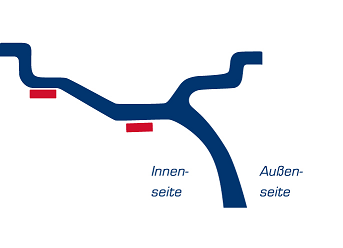 |
| Balancing using knock-on or safety weights for both levels. This type requires least mass for balancing. Most car manufactures use this option. | Balancing by using adhesive weights for both levels. The weights are affixed to the inner or outer plane of the wheel in the outer most positions. |
Both adhesive weights are affixed on the inside of the wheel rim. The external balance level is in this case transferred back behind the spokes. |
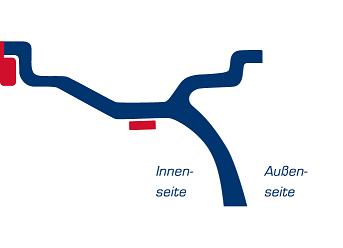 |
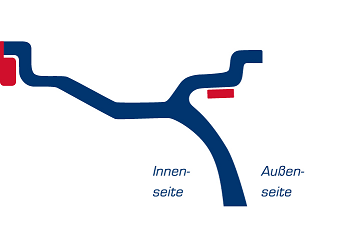 |
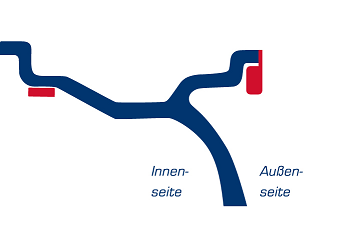 |
| The outer balancing level is relocated inside and the adhesive weight is attached in the rim centre in the brake disc area. A knock-on or safety weight is attached at the inner wheel rim flange. |
An adhesive weight is used at the outside of the rim. It is attached to the outer most position of the wheel. A knock-on or safety weight is used at the inner wheel rim flange. |
At the outer side of the wheel rim, a knock-on or safety weight is used at the rim flange. An adhesive weight is used on the inside of the wheel rim. The weight is affixed to the rim centre in the outer most position. |
Why are weights coated?
If uncoated balancing weights are mounted on a rim, it may come to contact corrosion. Contact corrosion occurs when metals with different nobility are in close contact. The more noble metal enhances the corrosion of the less noble metal. The condition for this process is a corrosive media between the two metals, like rain water or simple humidity.
Coated balancing weights preserve any rim from damage due to contact corrosion. The high quality OEM coating protects the weight optimally against environmental influences, even under extreme conditions. See comparison coated / uncoated weights in self-test on the right side. All weights are correspondingly subjected to OEM specifications 480 hours salt spray test according to DIN 9227 and ADTM B 117-73.
How often should you have your tyres balanced?
When changing seasonal tyres, the tyres should be regularly checked for imbalances due to everyday wear and rebalanced if necessary. "tyre balancing" is often included in workshop services.
In any case, you should balance your tyres when the first signs of imbalances appear. When the steering wheel begins to flutter or you feel vibrations when driving, you should have your wheels checked.
Attaching and removing adhesive weights
It is easy to attach adhesive weights to a rim, but it is not so easy to remove them from the rim without leaving any residue. There are different ways to remove adhesive weights.
Which tools do I use to remove adhesive weights or to remove stubborn adhesive residues from the rim? What are the reasons that my adhesive weights do not stick to the rim? Below you will find the answers to frequently asked questions about attaching and removing adhesive weights.
You want to balance tires or change a valve? Just click on the link and learn more about the respective topic!
How are adhesive weights mounted?
A prerequisite for the professional installation of adhesive weights is the selection of the correct position on the rim.
- The rim tilt must not exceed a slope of 15 degrees (axial direction) in any case.
- The weight adhesive can only develop when the surface energy is high enough to form a chemical bond. It should be at least 32nN/m.
- During the bonding process, the processing temperature should be between 10 and 30°C.
- The ideal processing temperature is between 16 and 25°C (please maintain a constant temperature for the storage of adhesive weights).
- Treat the surface with a cleaning agent that is compatible with the paint (e.g. Isopropanol 70%). At the selected position for the adhesive weight, the surface of the rim must be dry and free of grease, silicone and dust. On the surface to be adhered to, you must also remove any residue of prior adhesive weights.
Mounting the adhesive weight
- Choose the right amount of adhesive for your wheel. Carefully bend the adhesive weight (with protective film) forward along the radius of the rim. The adhesive weight should be bent slightly further than the rim radius. Remove protective cover from the adhesive. Make sure not to touch the adhesive area.
- Remove the protective film from the adhesive weight. Make sure that you do not touch the adhesive surface.
- Glue the weight parallel to the edge of the rim at the intended position.
- Press the adhesive weight onto the rim with a pressure of at least 10N/cm². Start in the middle and slowly move outwards.
Which tools do I use to remove adhesive weights
Removing adhesive weights often does not work without leaving residue on the rim. Getting the rim free of dirt and stubborn adhesive residues is often not easy. To avoid the use of environmentally harmful and aggressive cleaning agents or adhesive residue removers, there are specially designed tools that make it easier to remove the adhesive weight without damaging the rim or harming the environment. The following options can help you do this:
- Adhesive residue removers are often available as sprays. It is important to ensure that the agent does not attack rubber and metals and is biodegradable.
- With a scraper, you can not only remove adhesive residues on the aluminum rim, but also sealant and paint residues.
- A rubber eraser is the best way to remove brake flanks and adhesive residues from the rim. Before doing so, check whether the rubber eraser is also suitable for carbon rims.
- Rubber eraser discs are also ideal for removing dirt and adhesive residues from rims.
Why do my adhesive weights not stick to the rim?
There are many reasons why adhesive weights do not stick reliably to a rim:
- The temperature range during the application of adhesive weights on the rim should not fall below 16° C. Below this limit, the adhesive cannot work properly and the adhesive weights can not properly attach to the rim.
- For the adhesive to chemically bond with the surface of the rim, it is necessary to exert sufficient pressure on the adhesive tape for several seconds.
- Before applying an adhesive weight, it is also necessary to ensure that the surface is free of grease, silicone and dust. Cleaning agents with isopropanol are ideal for this purpose.
- The surface energy can vary depending on the density of the ink and varnish. Only if the surface energy level is high enough can the adhesive attach to the rim.
- The adhesive on the weight can only develop reliably if the surface energy is high enough for a chemical bond. It should be at least 32nN/m.
Balancing compound
How does balancing compound work?
In a running tire the balancing compound is dispersed along the tire walls due tothe centrifugal force. With increasing speed, imbalance of the wheel assembly (heavy spot) will cause vibrations like bouncing and wobbling. At the same time the higher speed will also cause the centrifugal force to disperse the material in the tire and automatically push the compound opposite to the heavy spot, compensating the vibrations. As the compound can fl ow freely in the tire, it will constantly adjust to shifts in forces caused by changed imbalances, speeds and road conditions, guaranteeing an always smooth ride.
What is Fusion Technology?
FUSION TECHNOLOGY – THE INTELLIGENT BALANCING COMPOUND:
The secret of the innovative Fusion Technology is the different size of the balancing material. The larger red kernels concentrate in the center of the tire and dampen the static imbalance. The smaller blue kernels are moving to the outside of the tire and compensate wobbling which is caused by dynamic imbalance. The result is a smooth ride for the complete tire life.
What are the benefits of balancing compound?
QUICK AND EASY BALANCING
No balancer required, tear open and into the wheel. Pre-packed bags mean low labour costs, no extensive training or experience required.
INCREASED FUEL EFFICIENCY
Smoother ride and reduced rolling resistance mean longer tyre life, better tread and contact to road, making you more efficient.
PROLONGED TYRE LIFE
Longer lasting tread and even tyre wear through fewer vibrations keeping your tyres running smoother and cooler, ultimately lasting longer.
TPMS SAFE
Specially coated compound has no adverse effects on TPMS sensors or inner tyre liners, high quality metal valve cap and a special core in every bag, protecting your valve.
MORE DRIVING COMFORT
Vibration dampening increases comfort, causing less exhaustion for driver. Fewer vibrations for load and driver mean both arrive fresh.
ENVIRONMENTALLY FRIENDLY
Lead-free, cost effective solution to balance all your wheels and almost all rim types, with no rebalance necessary saving dozens of wheel weights over a tyre life.
Why balancing compound of HOFMANN POWER WEIGHT?
FULL PRODUCT PROGRAM FROM THE MARKET LEADER
As the market leader in wheel balancing, we are proud to also offer a premium solution for vibration dampening through in-tyre compounds. We are the only manufacturer in Europe offering a full spectrum of heavy-duty knock-on and adhesive weights as well as an own line of vibration dampening products for in-tyre use.
A STRONG BRAND
Our premium product and packaging is paired with a strong brand. HOFMANN POWER WEIGHT is known as the most important supplier for wheel weights to vehicle manufacturers worldwide.
GARAGE OPTIMISED PACKAGING
The unique dispensing box, with its small footprint can easily be stored close to the balancer, no walking back to get product from the shelf. Bags can be dispensed from the front, while it opens from the top with a reclosable and removable lid.
SMALLER BOX QUANTITIES
With 8-16 bags per master box, a fourth of what competitors pack into master boxes, inventory can be managed more easily, binding less capital. The lower cost per box makes the product attractive even for shops without HD specialization.
ATTRACTIVE PRODUCT DESIGN
Premium product with its unique two colour design, paired with a high quality print and red and white HOFMANN POWERWEIGHT visual on boxes and bags maximise brand recognition and facilitate repeat business.
ALL-IN-ONE BAG
Each bag contains everything you need for your job, each has a filtered valve core and valve cap sealed into a separate compartment at the top.
EASY TO OPEN
Our perforated paper bags are easy to tear and incorporate a funnel-like opening to minimise spills. The single paper bag design reduces waste and is easy to recycle compared to competitors double plastic bag packaging.
INSTRUCTIONS ON EVERY BAG
Independent from language barriers, instructions on every bag in the form of pictograms show how the balancing compound is applied.
HIGH QUALITY COMPONENTS
Valve cap and filtered valve core provided in the bag are high quality components with red high temperature resistant seals. Each valve cap is marked with a clear logo, indicating the use of balancing compound in the tyre.
All HPW advantages at a glance in our flyer: |
Here you can find the HPW balancing powder in the WEGMANN automotive B2B Partner Shop: |
| To the Webshop |
Change car valve
Your tire loses air, but you can not find a leak? Have you ever thought about changing the car valve? Replacing the car valve is an often neglected yet essential simple task, although it is of enormous importance for driving safety. Check out our FAQ section to learn more about how to change a valve on a car tire, why valves are so crucial, and more on how to change tire valves.
A flat tire can have various causes. The tire can lose air due to abrasion, but also due to a hole caused by a foreign body disrupting the material. Another possibility would be a crack in the rim or it could be due to the valve. You should change your car valve when the car valve’s cap is missing or when the car valve is defective or broken.
Why is ist important to change the tyre valves?
Tyre valves undergo constant high levels of pressure. It is crucial to change the car valve when it is defective. Not enough pressure on tyres can lead to a dangerous extension of the braking distance by up to 70% on wet grounds and thus represents an enormous safety hazard. Loss of control or burst tyres are also possible consequences of the loss of pressure. In addition to the safety aspect, there is also an monetary aspect that underlines the importance to change the valve of car tyres regularly. Flat tyres lead to increased wear on the car and increased fuel consumption. Regular checking of the car tyres, changing the tyre valves and adjusting the air pressure is therefore of utmost importance.
How often should the tyre valve be changed?
A good time to have the tyres checked and the tyre valve changed is the seasonal tyre change. Maintenance procedures - just like balancing the tyres – are most of the time already included in this service. In general, however, how often a tyre valve has to be changed also depends on the type of valve used. While reinforced metal valves have a very long service life and should be replaced earliest after two seasons, the recommended period to change rubber valves is every six months. However, if the valve is defective or leaking before that time, you must act immediately to have the tyre valve changed.
In general, however, you should check your tyres regularly and especially before long journeys. Check the valves for external damage and check whether a protective cap is present. Is there enough air pressure in your tyres? Are all balancing weights still there? In case the answer to these questions is yes, you are good to go to have a safe ride.
How do I know if the tyre has a hole or if I need to change the tyre valve?
The tyre is losing air. What is the cause for that? Is there a hole in the tyre or do I need to change the tyre valve? There's a little trick you can do to find out. Mount the tyre on a car jack and spray the tyre with a spray bottle containing a mix of water and a few drops of detergent. Bubbles emerge if there is a hole. Otherwise, it is probably due to the valve. Then the car valve needs to be changed.
Is it possible to change the tyre valves yourself?
Can a tyre be repaired? Yes. Can you change a tyre valve yourself? Probably not. Changing the tyre valve can be difficult. In addition, the valve is very important for driving safety, so it is important to have a specialist carry out the change of the tyre valve.
Do I have to change the tyre valve if the protective cap of the valve is missing?
The protective cap is an important part of the valve. When the cap is missing, you should replace the tyre valve by buying a new one. Protective caps on valves prevent dirt, liquids and other contaminants ingressing the tyre. Dirt particles clog the valve and cause it to leak, resulting in a loss of pressure in the tyre. Drivers should therefore regularly check the protective cap and change the tyre valve if necessary.
Should I change to hidden tyre valves?
Many drivers wonder whether you should switch to hidden tyre valves when a change in tyre valves is due. These are becoming increasingly popular: they look better and also offer better protection. Hidden tyre valves are broader and flatter and have shorter tubes so that they do not protrude beyond the rim protection strip. As a result, the hidden valves cannot be damaged or torn off so easily. However, this type of valve is much more expensive and replacement is more difficult and time-consuming. Therefore it is up to each individual to decide whether or not to change to hidden tyre valves.
General questions about TPMS
What are universal sensors and original sensors? And how do direct and indirect TPMS differ? You will find many answers to your questions here in our FAQ section on tyre pressure monitoring systems.
What is the difference between direct and indirect TPMS?
A distinction is made between direct and indirect tire pressure monitoring systems.
Direct TPMS systems measure and record air pressure data with extreme precision using sensors that are built into the valves in the tires. The data is transmitted wirelessly to the vehicle’s on-board electronics system almost in real time and it also appears on the driver’s display.
Indirect TPMS systems use the so-called ABS system. This determines air pressure loss using the rolling circumference of the wheel. However, these ABS systems have very tight legal tolerances and, unlike direct systems, are not suitable for all vehicles.
Which areas are affected by TPM systems?
TPM systems should be considered in the following areas/situations:
- Diagnostics when the warning light appears on the display
- Maintenance, repair or replacement of the sensors
- Tire changes
- Assembly of complete wheels
- Tire repairs
- Tire fittings
- Service checks (e. g. general checks for TÜV)
How are the sensors installed in the wheel?
Special expert tools make it easier to install and remove sensors. They also ensure that the nut and valve for the sensor holder are fixed with the correct torque.
For mounting, you can choose either an aluminium or snap-in valve (rubber valve). Separate sensor versions are available for both types of valves (to ensure that the valve and sensor are compatible).
A snap-in valve is generally cheaper and easier to install than an aluminium valve. However, it should be considered that, because of the centrifugal force, a snap-in valve can not be used at maximum speeds above 210 km/h. Aluminium valves are suitable for speeds > 210 km/h.
Please note: the valve should be inspected every time you change the tire. This involves replacing the valve insert, valve cap, nut, washer and seal. Special service kits containing the necessary spare parts are available for this maintenance procedure.
What chenges to tire service processes result from using TPMS?
- Whenever you change the tires: install sensors in the wheels of vehicles with direct TPMS.
- To prevent the valve and sensor from corroding, replace the wear parts – valve insert, nut, seal and cap – using special service kits.
- Use diagnostics/programming tools to check the battery charge.
- Replace low or dead batteries: sensors have a finite battery life (varies between 4-10 years).
- Analyse and resolve the problem that has caused the warning light in the display to turn on.
- In general, in accordance with § 29 of the German Road Traffic Licensing Regulations (StVZO), a non-functioning TPMS is classified as a minor fault and must be rectified immediately by the vehicle owner. A workshop needs to be able to correct this fault at any point.
How can a workshop prepare for servicing tires with TPMS?
The obligation to have TPMS presents workshops with completely new challenges. In particular, new questions arise regarding the technology for direct TPMS. Experience shows that the market development and spread of TPMS are progressing at great speed. It is, therefore, both reasonable and necessary for workshops to prepare ahead for servicing tires with TPMS.
What does a workshop need to bear in mind to prepare in the best possible way for working with direct TPMS on a daily basis in the future?
- The most essential thing: prepare well for the customer handover. That means establishing the vehicle details, determining whether it has direct or indirect TPMS and obtaining information about the TPMS, as well as being transparent when explaining and justifying the additional costs involved.
- Just as important: train employees to use the new technology.
- Money is also important: investment is needed in suitable sensors and the correct diagnostics and programming tools.
- Stay ahead of the competition: workshops should gain an early competitive advantage by informing their customers about their TPMS service.
- It’s not just about outward appearances: it is also important to optimise and adapt internal tire service processes.
- To guarantee customer satisfaction, communicate the duration and prices for tire servicing needed for adjusting vehicles with direct TPMS.
- Record everything on paper or in the system: document the condition of the TPMS both before and after any work is done.
What is the process when servicing tires with TPMS?
- Check the warning light and the indicator on the vehicle’s display – if the light is on, diagnostics are needed to determine whether there is a system error or loss of air pressure (see vehicle logbook).
- Check the valve: Is the seal damaged? Is there any corrosion?
- Scan the sensors using a diagnostics/programming tool.
- Document the scan results (initial status of the vehicle’s TPMS).
- Execute the customer order, e.g. change the wheels, replace the tires or sensors, service the valve. When necessary, reconfigure the (new) sensors to the vehicle and check the TPMS.
- Document the status of the vehicle’s TPMS at the end (the TPMS status must not be worse than the initial status) and inform the customer.
Please note: As a functioning TPMS is part of the operating licence, the workshop must ensure functionality after every repair. Corresponding documentation of the status of the TPMS before and after carrying out maintenance and diagnostics and completing the customer order, therefore, acts as a safeguard within the scope of liability and warranty.
Which sensors can be used for the TPMS?
There are over 150 different sensors on the market.
Requirements:
- The sensors must be pre-programmed for the vehicle.
- The vehicle and sensor must be compatible, i.e. not every sensor can be fitted in every vehicle.
- For winter tires/spare tires or where a sensor is replaced, it is possible to use either original sensors or unprogrammed universal sensors.
What are universal sensors?
Universal sensors are not pre-programmed and can therefore be easily integrated into most vehicles. The advantage: The workshop does not have to stock a large number of original sensors in order to serve all customers as required. A good basic stock of universal sensors is completely sufficient.
A special programming tool is also required for the universal sensors in order to be able to programme the sensors for specific vehicles. This programming tool is first used to query the vehicle's technical data and then to determine the position of the tyre in which the sensor to be programmed is located. The original sensor is then recognised by the programming device and the collected data is used to program the new sensor. The original sensor is thus imitated, so to speak. If no old original sensor is available, a new sensor ID can also be created using the programming tool.
What are original sensors?
Original sensors are already pre-programmed with the vehicle-specific details. This means that original sensors can only be used in certain vehicles designed for this purpose. Due to the large number of different sensors, however, the workshop's stock and tied-up capital would increase, as at least 4 of the most important original sensors should always be in stock in order to be able to serve customers satisfactorily.
Questions about sens.it® TPMS
Which vehicles are coverd by ALLIGATOR sens.it®?
You will find the relevant coverage list in our download section or in the sens.it® application software. This list is updated regularly, as soon as new vehicles are available.
The vehicle can not be found via VIN/KBA but, according to the coverage list, sens.it® supports it. What should I do?
When this problem occurs, please try to find the vehicle by selecting the ‘Manufacturer & Model’ option instead.
Can the sensor ID also be determined without using a special diagnostics tool?
When no diagnostics tool is available, it is also possible to read the ID directly off the case of (most) sensors.
Does ALLIGATOR offer a TPMS diagnostic tool?
In cooperation with partners, the TPMS diagnostic tools PT3 and PT4 are offered under the ALLIGATOR brand. You can find the devices in our WEGMANN automotive B2B Partner Shop.
Is it possible to read sensors using the ALLIGATOR programming tool?
The ALLIGATOR sens.it® programming tool was developed to communicate with sens.it® sensors. It is therefore not possible to use this device to read sensor data of any kind.
Can the ALLIGATOR programming tool used to write to other sensors?
sens.it® is a complete product system. It is, therefore, not possible to program sensors made by other manufacturers.
How can a duplicate (clone) of an OE sensor be produced with sens.it®?
A duplicate of this component can be produced using the serial number (ID) of the OE sensor that is currently installed in the vehicle and which needs to be replaced. This procedure eliminates the need to reconfigure the sensor with the vehicle – a clear advantage in terms of saving time and improving customer service.
There are two options for determining the ID number:
- Getting an electronic read-out of the sensor ID number using a diagnostic device, or
- Reading the ID straight off the sensor case after removing the tire.
For programming, this ID number is entered into the 'OE sensor ID' data field. Detailed instructions for the whole programming procedure can be found in the installation instructions provided under 'information material' in our downloads section.
Important: Always make a note of which sensor was fitted to which wheel!
When is it necessary to relearn the sensors?
When a new sensor ID is created, the sensors must be reconfigured with the vehicle.
How are sensors relearned to the vehicle?
The relearning methods for vehicles vary considerably. Fundamentally, there are three different versions: automatic relearning, via the OBDII interface in the vehicle or manual relearning via the on-board computer. To determine which method should be used, check the vehicle handbook or contact the manufacturer.
Can tires be fitted with sens.it® sensors in advance or is the whole vehicle needed on site?
When a set of tires is being prepared before the vehicle arrives, then the sens.it® sensor can be programmed in advance. To do this, select the correct vehicle and generate a serial number (ID) for the sensors of concern (AutoGenerateID button). In this case, a relearning procedure must be carried out after fitting the set of wheels.
The sensor has been programmed for the wrong vehicle. Can a sensor be programmed again?
A sensor that has been accidentally programmed for the 'wrong' vehicle can be reprogrammed multiple times.
How many OE sensors per vehicle can be replaced with sens.it® sensors?
Any number of OE sensors per vehicle can be replaced with sens.it® sensors.
How long does a sensor battery last?
A sensor battery typically lasts 5 to 7 years.
Is it possible to change the sensor battery?
When the diagnostics for the sensor indicate an empty battery, the whole unit has to be replaced.
Is there a difference between the different coloured valves?
From a technical perspective, all valves are constructed in the same way. The difference in colour only serves to customise the look of the valve for a particular wheel or vehicle.
How is TPM handled on imported vehicles (315MHz)?
According to current EU regulations, the 315 MHz frequency can not be used in Europe for tire pressure monitoring.
The tire pressure is not equally distributed - when will the warning be activated?
As soon as the pressure in one of the tires drops below the threshold value set in the vehicle, the system will warn the driver. The settings are usually to be found directly on the vehicle, whether inside the fuel tank cover or on the inside part of the driver’s door.
Can sensors be used with indirect TPM systems?
Vehicles with indirect tire pressure monitoring use ABD/ESP systems and determine the tire pressure based on algorithmic data. No direct measurement by TPM sensors is needed for this.
